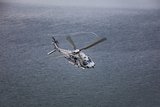Raytheon to prime in US Army's CIRCM competition
Raytheon Company will pursue a prime contractor role in response to the US Army's Common Infrared Countermeasures (CIRCM) request for proposal. CIRCM will protect combat helicopters and other aircraft by jamming the infrared guidance systems of heat-seeking missiles and diverting the missiles away from the aircraft.
Raytheon's CIRCM solution, known as Scorpion, will feature the company's production-matured directed infrared countermeasures turret and a rugged quantum cascade laser. Scorpion will be a light-weight, low-cost, highly reliable laser-based infrared countermeasure solution against current and future IR-guided threat missiles.
"Raytheon's Scorpion leverages the Department of Defense's multibillion dollar investment in the production of air-to-air missile seekers and the commercial world's development of quantum cascade lasers," said Mike Booen, Raytheon's vice president of Advanced Security and Directed Energy Systems. "By combining a light-weight, highly reliable quantum cascade laser with fiber coupling hardware, the Scorpion system provides the best solution for the Army's CIRCM requirement."
Scorpion has a mean time between failure rate far greater than any other system on the market. Minimizing impact on mission availability, a high MTBF rate results in less maintenance, reduced ownership costs and significantly less downtime.
"Raytheon's Scorpion is designed with the warfighter in mind," said Booen. "The weapon's open system architecture makes it compatible with the majority of missile warning systems on combat aircraft platforms in operation today."
Raytheon began developing the Scorpion solution in 2005. During range testing, the company demonstrated the pointer tracker's ability to acquire, track and defeat IR missiles in flight with 100 percent success.
Raytheon also flew its prototype CIRCM system on a UH-1 helicopter. While flying in an operationally relevant environment, the prototype detected, tracked and applied laser energy to a simulated threat. The system met all performance requirements from a variety of distances, altitudes, airspeeds and bank angles.
Source: Raytheon
More from Defence Helicopter
-
![Germany to send WS-61 Westland Sea King helicopters to Ukraine]()
Germany to send WS-61 Westland Sea King helicopters to Ukraine
Germany has committed to sending Ukraine six of its 21 retiring WS-61 Westland Sea King multirole, amphibious helicopters.
-
![Boeing secures $271 million to advance modernisation of US Special Operations' MH-47G Chinook]()
Boeing secures $271 million to advance modernisation of US Special Operations' MH-47G Chinook
Boeing has clinched a major contract modification to further its backing of the US Special Operations Command’s MH-47G Chinook aircraft modernisation effort.
-
![Dubai Airshow 2023: South Korean homegrown helicopters make international debut]()
Dubai Airshow 2023: South Korean homegrown helicopters make international debut
Two KAI helicopters, the KUH-1E utility helicopter and the Light Attack Helicopter (LAH), have taken centre stage at the Dubai Airshow 2023.
-
![Italian Navy receives final NH90 helicopter]()
Italian Navy receives final NH90 helicopter
The Italian Navy now boasts a fleet of 56 NH90 helicopters comprising 46 SH-90As and 10 MH-90As.
-
![Argentina seeks AW109 and CH-46 Sea Knight helicopters]()
Argentina seeks AW109 and CH-46 Sea Knight helicopters
The Argentinian Air Force (FAA) and the Argentinian Naval Aviation Command (COAN) are looking for options to upgrade their helicopter fleets.
-
![DSEI 2023: Lockheed to produce about 40% of Black Hawks on UK soil if it wins NMH contest]()
DSEI 2023: Lockheed to produce about 40% of Black Hawks on UK soil if it wins NMH contest
Lockheed Martin promises a boost to the British job market and export opportunities, while strengthening ties with Poland and positioning the UK for a future in rotorcraft technology in the event of a New Medium Helicopter competition triumph.


























